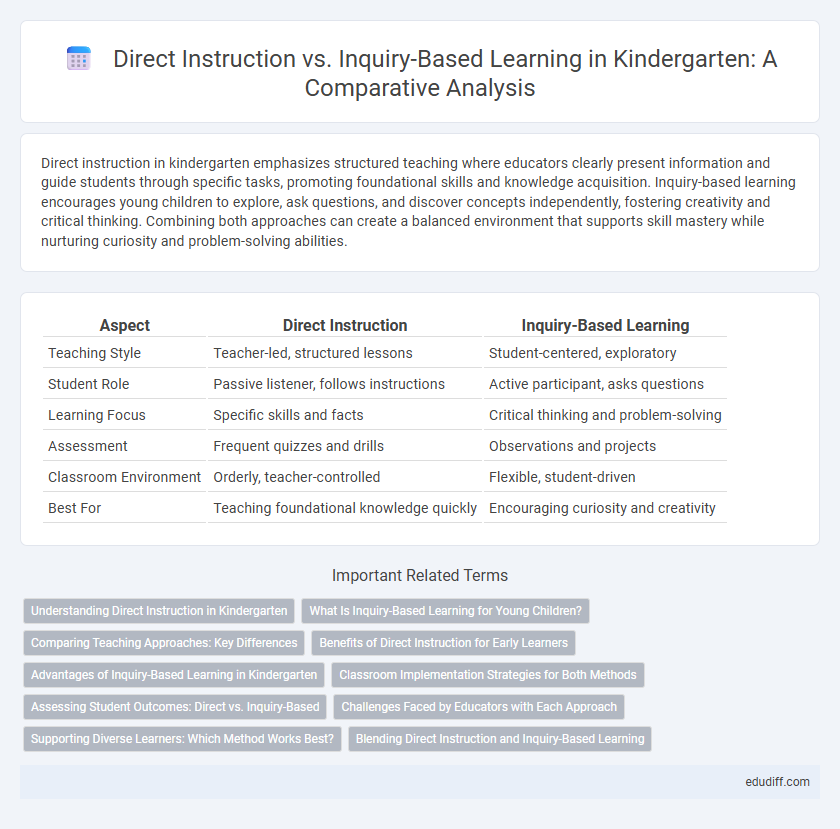Direct instruction in kindergarten emphasizes structured teaching where educators clearly present information and guide students through specific tasks, promoting foundational skills and knowledge acquisition. Inquiry-based learning encourages young children to explore, ask questions, and discover concepts independently, fostering creativity and critical thinking. Combining both approaches can create a balanced environment that supports skill mastery while nurturing curiosity and problem-solving abilities.
Table of Comparison
| Aspect | Direct Instruction | Inquiry-Based Learning |
|---|---|---|
| Teaching Style | Teacher-led, structured lessons | Student-centered, exploratory |
| Student Role | Passive listener, follows instructions | Active participant, asks questions |
| Learning Focus | Specific skills and facts | Critical thinking and problem-solving |
| Assessment | Frequent quizzes and drills | Observations and projects |
| Classroom Environment | Orderly, teacher-controlled | Flexible, student-driven |
| Best For | Teaching foundational knowledge quickly | Encouraging curiosity and creativity |
Understanding Direct Instruction in Kindergarten
Direct Instruction in kindergarten emphasizes structured, teacher-led lessons that focus on clear, explicit teaching of foundational skills such as phonics, numeracy, and fine motor tasks. This approach ensures consistent skill acquisition through repetition, modeling, and immediate feedback, crucial for young learners' cognitive development. Research highlights its effectiveness in establishing early literacy and math competencies, providing a solid foundation for future academic success.
What Is Inquiry-Based Learning for Young Children?
Inquiry-based learning for young children emphasizes exploration and hands-on experiences, encouraging curiosity and critical thinking through open-ended questions and discovery. This approach fosters language development, social skills, and cognitive growth by allowing children to investigate topics that interest them in a supportive environment. Young learners actively construct knowledge, making learning more meaningful and engaging compared to passive reception of information.
Comparing Teaching Approaches: Key Differences
Direct Instruction in kindergarten emphasizes structured, teacher-led lessons with clear objectives and repetitive practice, ensuring foundational skills are mastered efficiently. Inquiry-Based Learning fosters curiosity and critical thinking by encouraging children to explore topics through questions, experimentation, and hands-on activities, promoting deeper understanding. These approaches differ fundamentally in control dynamics; Direct Instruction prioritizes teacher control and predictable outcomes, whereas Inquiry-Based Learning values student autonomy and exploratory processes.
Benefits of Direct Instruction for Early Learners
Direct Instruction provides early learners with clear, structured guidance that supports foundational skill acquisition in literacy and numeracy. Consistent, explicit teaching methods enhance focus and reduce cognitive overload, fostering quicker mastery of basic concepts. This approach builds confidence and sets a strong academic foundation essential for future learning success in kindergarten.
Advantages of Inquiry-Based Learning in Kindergarten
Inquiry-based learning in kindergarten fosters critical thinking and creativity by encouraging children to explore and ask questions actively. This approach promotes deeper understanding and retention of concepts compared to rote memorization. Early engagement in inquiry-based activities enhances social skills and independence, preparing young learners for future academic challenges.
Classroom Implementation Strategies for Both Methods
Direct Instruction in kindergarten classrooms involves structured lesson plans with clear, explicit teaching goals, frequent assessments, and teacher-led demonstrations to reinforce foundational skills like literacy and numeracy. Inquiry-Based Learning strategies emphasize student exploration and curiosity by incorporating hands-on activities, open-ended questions, and collaborative problem-solving tasks that develop critical thinking and creativity. Effective implementation blends scaffolding in Direct Instruction with guided discovery in Inquiry-Based Learning to balance skill acquisition and conceptual understanding.
Assessing Student Outcomes: Direct vs. Inquiry-Based
Direct instruction in kindergarten typically yields measurable gains in foundational skills such as letter recognition and counting, supported by frequent formative assessments that track student progress. Inquiry-based learning fosters critical thinking and problem-solving abilities, with assessment focusing on students' ability to ask questions, explore concepts, and demonstrate understanding through creative projects. Comparing student outcomes, direct instruction shows efficient skill acquisition, while inquiry-based approaches promote deeper cognitive development gauged by observational and performance-based evaluations.
Challenges Faced by Educators with Each Approach
Direct Instruction in kindergarten often poses challenges such as limited opportunities for student creativity and difficulty in maintaining engagement among diverse learners. Inquiry-Based Learning requires educators to balance guiding exploration with ensuring curriculum standards are met, which can be time-consuming and demands extensive teacher training. Both methods demand tailored classroom management strategies to address varying attention spans and learning paces in early childhood education.
Supporting Diverse Learners: Which Method Works Best?
Direct Instruction offers structured guidance and clear objectives, benefiting diverse learners by providing predictable routines and explicit teaching of essential skills. Inquiry-Based Learning fosters curiosity and critical thinking, allowing students with varied learning styles to explore concepts actively and develop problem-solving abilities. Combining both methods can create a balanced learning environment that supports the unique needs of kindergarten students by integrating focused instruction with opportunities for exploration.
Blending Direct Instruction and Inquiry-Based Learning
Blending Direct Instruction and Inquiry-Based Learning in kindergarten enhances foundational skill acquisition while promoting critical thinking and creativity. This hybrid approach uses explicit teaching for core concepts and guided exploration to encourage curiosity and problem-solving. Research indicates students in early education benefit from structured guidance paired with opportunities to investigate and discover, fostering deeper engagement and retention.
Direct Instruction vs Inquiry-Based Learning Infographic

 edudiff.com
edudiff.com